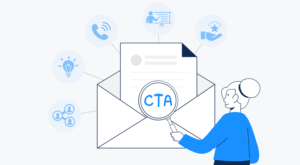What is a Call to Action? + Types of CTA (Call to Action)
A Call to Action is an interactive and predetermined element on a website or application page that invites the audience to take action to increase return on investment (ROI). This action can include purchasing a product, downloading a file on the site, purchasing a subscription, etc. Any business can experience extraordinary and unique sales with a creative and attractive call to action. But what are the essential points in designing and writing a CTA, and how can you create a beautiful and captivating call to action? Join us as we explore this key question and more.
What is a Call to Action?
CTA stands for Call-To-Action and helps businesses convert visitors or readers into leads for the sales team. A call to action is a request on a site or app asking users to take a specific action per your marketing team’s goals. A CTA can appear as a clickable button and is often seen directly on the page, in a pop-up, or digital marketing ads. When customers click on a call-to-action button, they are one step closer to becoming buyers.

A call to action can take many forms depending on your marketing team’s goals:
Sign up today!
Try this free 14-day trial!
“Buy Now” or “Download Now”
Get 20% off your first order.
Learn more
Add to cart
Follow us on Instagram
Schedule a free consultation
Share this post with your friends
Why is it essential to use a call to action?
A call to action (CTA) is a key element in a business and acts as a signpost to let users know exactly what to do. Without a clear CTA, a user may not know the next steps to purchase a product or sign up and will likely leave your site without taking any action. A CTA informs customers what their next action should be and helps move users down the funnel and into the final stages of the sales funnel.
For example, if a visitor searches for one of your blog articles without a clear call to action in that context, the person will likely leave the site without further action. However, having a CTA at the bottom of your content that asks people to read other articles or sign up for an advertising campaign will encourage them to continue interacting with your site.
Types of Calls to Action

There are many types of calls to action, and you can use different types to guide your audience and make them more successful in the customer journey. For example, one marketing campaign might use a form submission to attract more viewers. At the same time, another campaign might encourage users to “Learn more” on your site.
Below, we’ll look at some of the most common types of CTAs used in marketing. However, remember that every brand and every audience has different tastes. Therefore, it’s best to A/B test the types of CTAs specified on your site to find out which resonates with your business based on your audience’s tastes and understanding.
CTA Buttons
By far, the most common type of CTAs are buttons. Buttons are icons with useful phrases that encourage users to click and take further action. Button designs can vary based on your brand style and campaign goal. Call-to-action buttons should generally be high-contrast colors to stand out on the page. The following button is a simple example of a CTA:
Forms
Form submission calls-to-action convert site visitors into leads by offering them something in exchange for their contact information. These offers can include free downloadable content, product pricing, service sign-ups, subscriptions, discounts, freebies, giveaways, and more.
Banners
CTA banners can be placed at the top, bottom, or side of website pages. Call-to-action banners are usually designed in an attractive and eye-catching way that encourages visitors to click on them. You can see two CTA banners on the left side of this article on desktop (or at the bottom on mobile).
In-text links
In-text links, which are usually included in a blog post, contain clickable text that directs users to a relevant landing page. The content displays These anchor texts in blue, orange, and bold. These clickable texts are considered anchor text in this article.
Pop-ups
A pop-up is a small window suddenly appearing on the page and is an efficient example of a call to action. Many websites use pop-ups to prevent users from leaving, and they are activated if users intend to leave the site. Of course, it should be noted that in most cases, these pop-ups are very annoying and hurt the site’s SEO.
Slides
Slide calls to action, like pop-ups, are also placed on the side or bottom of the site to attract users’ attention. However, slides are less intrusive to users than pop-ups.
Essential Tips for Designing and Writing CTA

There is no fixed formula for writing a CTA. However, you should try different CTA forms and choose a call to action that will attract your audience’s attention to a large extent. But you can use this method to write a compelling call to action.
Problem + Solution + Action
Use a strong verb to start the CTA.
Use the correct verbs since you have little space to convey your point in your call to action. In fact, in a button, let your audience know precisely what you want them to do. If you use a call to action in the following areas, you can get help from the introduced verbs.
Start with a call to action for a shopping website like “Buy” or “Order.”
If promoting a newsletter or content, use “Download” or “Subscribe” for the CTA.
For service businesses, use phrases like “Call Now” or “Book Your Service.”
Remember that phrases like “Our newest clothes are now available” do not motivate people to take further actions such as registering or purchasing when using calls to action. Instead, it is better to use more direct and clear phrases like “Click here to access the latest styles of the day.”
Use emotional and passionate words.
If you want to increase clicks and conversion rates, you need to attract the attention and emotions of your audience. Imagine someone looking to book a trip or a family tour. If they come across a call to action like “Plan your dream vacation today,” they will dream of an exciting journey and eagerly respond to your invitation.
Give Your Audience a Reason to Act
You must give people a reason to click for a compelling call to action. What will your business’s call to action button do for them? Is it telling them how to get rich? Or is it telling them how to lose weight? For example, you could use a CTA like “Contact us to start saving money today” to promote your business.
Device-Friendly CTA
It’s essential to make your CTA relevant to the device your audience is most likely to use. Since nearly 80 percent of searches for local businesses are done on mobile devices, tailoring your CTA to those devices is a good idea.
A/B Testing for CTA
A/B testing is a great way to see which CTA works best for your business. With A/B testing, you can test some creative CTAs and compare them to your old standards. If your target audience isn’t responding well to your ads, getting it’s getting creative with your calls to action is a good idea.
Use Numbers
Consumers usually respond positively to numbers. For example, if a user sees the price of a product in your ad and decides to visit your site, you know they’re interested in the product or service you offer. Try using phrases like “Today only, get $30 off all mobile accessories!” in your calls to action for once.
Create a sense of urgency.
Add a time element to your call to action to create a sense of urgency. This will encourage your audience to act quickly instead of procrastinating. Creating a sense of urgency can reinforce the fear of missing out (FOMO).
The best place for a CALL TO ACTION button
The placement of a CALL TO ACTION button depends on several factors, such as the type of CTA, the purpose of the CTA, and the kind of content on the page where the CTA button is placed. Generally, the best place for a CTA button is a space visible to users that compels people to react. The location of this button can be at the top of the page, at the bottom of the page, or next to the page’s main content. In addition, you need to consider the type of CTA button. If the call to action is a simple request like registering, it can be placed anywhere on the page. However, if the call to action is a more complex request like “buy,” it is better to place it in a place that attracts users’ attention. Ultimately, the best place for call-to-action buttons requires testing, and you should see which part of your site has the highest click-through rate with different experiments.
What is a call to action on Instagram?

Call to action on Instagram works like a call to action on a website and is focused on getting your audience to take a specific action. CTA on Instagram refers to an invitation to do something in posts and stories to encourage your audience to take a particular action. These activities aim to increase engagement with your audience, promote products and services, attract new audiences, and increase sales.
Examples of calls to action on Instagram
Save this post
Ask me any questions you have
If you agree, share this post with your friends
To read more, scroll through the posts
Story (Which do you prefer? Cloudy or sunny weather)
Like this post and leave your comments
A few examples of successful CTAs from leading brands
Successful brands use clear, concise, and compelling CTAs to encourage customers. In this section, we will examine some examples of CTAs from successful brands.

Netflix
CTA: Free 1 Month Membership
Netflix’s free 1-month one-month membership call-to-action, which matches the color of its logo, has caught the attention of many worldwide users. This color contrast not only grabs visitors’ attention but also encourages them to click through with the clear and concise language in the CTA.
Uber
CTA: Sign Up to Drive | Start a Ride with Uber
Uber uses many calls to action in its business to engage drivers and passengers. Drivers and passengers are both looking for completely different options, and Uber has made these options available to people well with a large video that plays in the background.
Spotify
CTA: Go Premium and Play for Free
Spotify is a popular music streaming service with millions of users worldwide. One reason Spotify is so successful is its effective CTAs. Spotify’s CTAs are designed to encourage users to sign up, listen to music, or share content.
Amazon
Amazon is one of the most successful e-commerce companies in the world. One reason for its success is its use of effective CTAs. Successful Amazon CTAs are displayed on the site with phrases such as Buy Now, Add to Cart, Limited Time Special Discounts, and a 30-day Money Back Guarantee.
Final Words
A call to action, or CTA, is used to increase the success of digital advertising and sales funnel management. It means a clear and concise statement or command that encourages the audience to take a specific action. This action can be seen on the site or in applications with phrases such as “Shop our store on Black Friday and get up to 50% off!” “Download our free e-book on how to create video content.”